EOS-448 depletes immunosuppressive Treg cells, and EOS-448 stimulates cytokines to activate more immune cells.
3) Regulatory T cells (Tregs) inhibit the anti-tumor function of cytotoxic T cells. EOS-448 binds to TIGIT which is highly expressed on the surface of Tregs and stimulates NK cells and macrophages via FcγR engagement. This releases cytotoxic T cells inhibition and enhances tumor cell killing.
4) NK and macrophage activation stimulates the release inflammatory cytokines that signal and activate other immune cells to further augment the anti-tumor response.
This figure illustrates a third and fourth mechanisms by which EOS-448 mediates the depletion of immune suppress cells, namely Tregs and stimulates cytokines to activate more immune cells.
From the left a, dominant sphere depicts an immunosuppressive Treg cell expressing two TIGIT receptors, which are drawn on the right embedded in the membrane and parallel to each other as 2 pronged forks with a each double handle. The TIGIT receptor prongs each point right toward two smaller spheres arranged vertically. The sphere on the top is depicts an NK cell and the sphere below is depicts a macrophage both targets of the Treg. On the left side of each sphere, drawn embedded in the membrane of the NK and the Macrophage are FCgamma receptors, shaped similarly like 2 pronged forks but with single handles rooted in the membrane. The FCgamma receptors point out towards the Treg each in line with a corresponding TIGIT receptor. EOS-488 a antibody is usually depicted as a y shaped object. Here two EOS-488 antibodies drawn on its their sides with the upper part of the Y binding to TIGIT on the Treg and using the low part of the Y, simultaneously bind to the FCgamma receptors on the NK and Macrophage. The upper part of the Y also now as the variable or light chain region, binds specifically to TIGIT, the lower part of the Y know as the heavy chain or constant region bind to the FCgamma receptor. Arching dotted arrows above and below from the NK cell and macrophage respectively, the engagement leads to killing of the Treg by the NK cell and release of proinflammatory cytokines by the macrophages. The cytokines are drawn as small dots dispersing from the right side of the macrophage towards small immune cells drawn on the far right as even smaller spheres (NK and T) and irregular spheres (APC). These cytokines further enhance the immune response activating Tumor specific Tcells, NK cells and APCs mentioned above.
